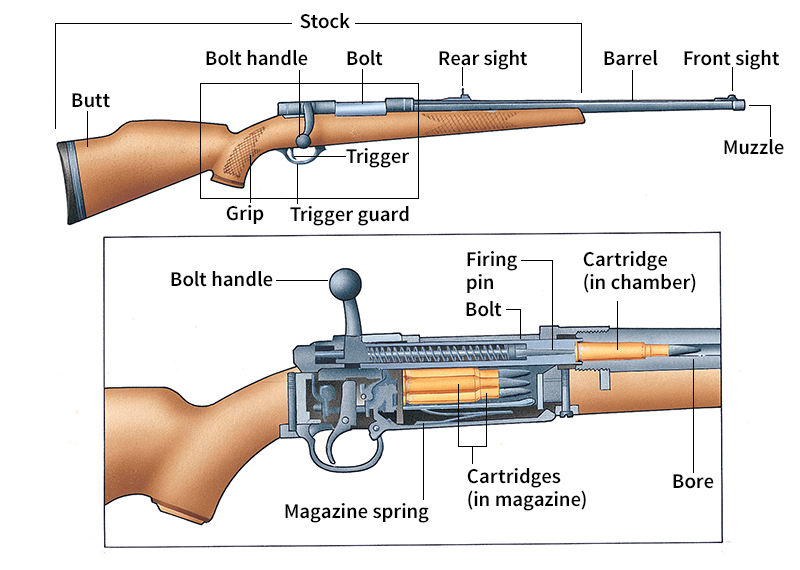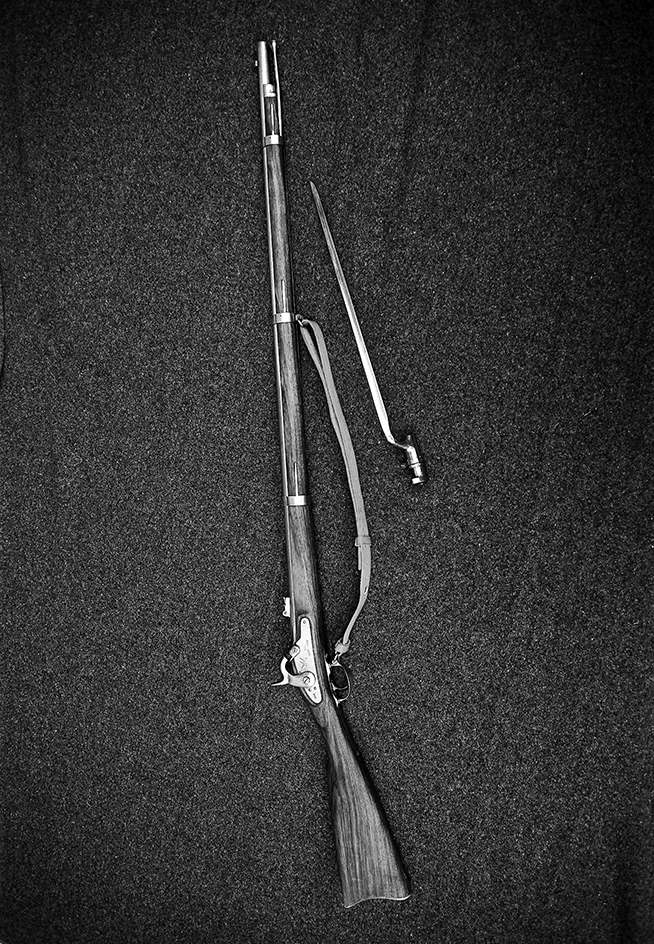Rifle is a gun with spiral grooves in its long barrel that spin the bullet as it is shot. Rifles are usually held against the shoulder when firing. Soldiers use rifles in battle. People also use rifles to hunt game and to compete in shooting matches.
Military rifles and sporting rifles differ greatly. Military rifles are ruggedly built and are designed to work under the harshest conditions. Most military rifles are automatic or semiautomatic. An automatic rifle can fire bullets rapidly one after another with one squeeze of the trigger. A semiautomatic rifle fires and reloads one bullet with each squeeze of the trigger. Most hunting and target rifles are operated by hand after each firing and are designed for beauty as well as accuracy.
The parts of a rifle
All rifles have four basic parts: (1) the barrel, (2) the stock, (3) the action, and (4) the sights.

The barrel is a strong steel tube with spiral grooves called rifling cut along the inside. The front end of the barrel is called the muzzle, and the rear end is the breech.
The stock of a rifle helps keep the rifle steady when firing. The butt of the stock is placed against the shoulder when firing. The front end extends under the barrel. Stocks of military rifles are made of wood, plastic, metal, or fiberglass. Many sporting rifles have stocks made of expensive wood with decorative or grip-aiding carving called checkering.
The action is the basic machinery of the rifle. The action includes the parts that feed a cartridge into the firing chamber. A cartridge is a metal case that holds an explosive charge and a bullet. The firing chamber, which holds the cartridge, is a widened hole at the breech. The action also includes the parts that fire the bullet and eject (force out) the used cartridge.
The sights are used to aim the rifle. When aimed properly, the rear sight, the front sight, and the target should be in a straight line. Some rifles have telescopic sights that make distant targets appear closer.
How a rifle works
A rifle is ready to be fired when a cartridge has been fed into the firing chamber. Then the rifle is aimed and the trigger squeezed. The rifle’s hammer or firing pin strikes the rear end of the cartridge and ignites the primer. The primer in turn ignites the propellant powder in the cartridge. The powder burns rapidly, creating pressure that drives the bullet down the barrel.
The rifling in the barrel makes the bullet spin. Without spin, a bullet would not stay pointed forward in flight, but would tumble over and over. The spinning motion increases the accuracy of a bullet.
Kinds of rifles
Rifles are classified by type of action (manually operated, automatic, or semiautomatic); by the name of the designer or manufacturer (for example, Remington or Winchester); or by caliber. Caliber may refer to the inside diameter of the barrel or the diameter of the bullet. The caliber is measured in millimeters or in decimal fractions of an inch.
There are three kinds of repeating rifles with hand-operated actions—bolt-action, lever-action, and slide-action. These rifles have magazines (cartridge holders) that feed cartridges into the firing chamber. The action on two other kinds of rifles—automatic and semiautomatic—is operated by forces caused by the burning of the propellant powder in the firing chamber.
Bolt-action rifles
have an action that resembles a bolt used to lock a door. When the bolt on the rifle is pulled back, the used cartridge is thrown out and the hammer is cocked. When the bolt is moved forward, it pushes a new cartridge into the firing chamber.
Lever-action rifles
are loaded by moving a lever under the breech down and back up. The down movement throws out the used cartridge and cocks the hammer. The up movement inserts a new cartridge into the firing chamber.
Slide-action rifles,
also called pump-action rifles, are loaded with a back-and-forth movement of a rod and handle beneath the front part of the barrel. When the handle is pulled back, the breech opens and the used cartridge is thrown out. A live cartridge is inserted when the handle is pushed forward.
Automatic and semiautomatic rifles
are used mainly by soldiers and police officers. When a rifle is fired, gas is formed by the burning powder in the firing chamber. The expanding gas drives the bullet out of the barrel. In most modern automatic and semiautomatic rifles, some of this gas operates the action. When a cartridge is fired, a fresh cartridge is moved out of the magazine into the firing chamber, and the firing mechanism is cocked.
The M16A2 is the automatic rifle used by the U.S. armed forces. It weighs 8.9 pounds (4 kilograms) when loaded with a 30-cartridge magazine. The M16A2 can fire one shot at a time, or three shots in a single burst. It uses a 5.56-millimeter cartridge.
Rifle cartridges
Rifle cartridges are enclosed in a casing (metal covering) made of brass or steel. Cartridges vary in size according to the caliber of the rifle. The names of some cartridges include the year the cartridge was put into use. The .30-06 is a .30-caliber cartridge chosen for use by the U.S. Army in 1906. The classification of some cartridges includes the caliber and velocity (speed) of the bullet. The bullet from a .250-3000 cartridge has a velocity of 3,000 feet (910 meters) per second.
History
Modern rifles developed from the crude, muzzle-loading firearms of the 1400’s. Rifling of barrels was invented in Europe about 1500. Smoothbore firearms (weapons without rifling) could not be depended on to hit targets more than 100 steps away.
The jaeger rifle of central and northern Europe was the first accurate rifle. It was developed about 1665. German immigrants brought jaegers to Pennsylvania in the early 1700’s and gave them new features, including longer barrels. The Pennsylvania-made Kentucky rifle developed from the jaeger. Some Kentucky rifles were used in the Revolutionary War in America (1775-1783).
Rifles used round bullets until the 1850’s, when more accurate Minie bullets became popular. Minie bullets had hollow bases and pointed tips and were used in the U.S. Civil War (1861-1865). Improvements of the late 1800’s included repeating rifles, smokeless explosive powder, and jacketed bullets, which have a tough metal cover over a lead or steel core.

